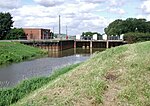Alexandra Dock engine shed (Hull)
Hull and Barnsley RailwayKingston upon HullLondon and North Eastern RailwayNorth Eastern Railway (UK)Rail transport in Kingston upon Hull ... and 2 more
Railway depots in YorkshireUse British English from October 2019
Alexandra Dock engine shed (Hull) was an engine shed located in Kingston upon Hull, Yorkshire, England and was opened by the Hull Barnsley and West Riding Junction Railway and Dock Company (HBR) in July 1885. The shed was closed by British Railways in October 1963 although the site remained in use as a stabling point and signing on point for drivers until rail traffic ceased to the dock in 1982.
Excerpt from the Wikipedia article Alexandra Dock engine shed (Hull) (License: CC BY-SA 3.0, Authors).Alexandra Dock engine shed (Hull)
Hedon Road, Hull Marfleet
Geographical coordinates (GPS) Address Nearby Places Show on map
Geographical coordinates (GPS)
| Latitude | Longitude |
|---|---|
| N 53.746701 ° | E -0.293883 ° |
Address
Hedon Road
Hedon Road
HU9 5LR Hull, Marfleet
England, United Kingdom
Open on Google Maps









